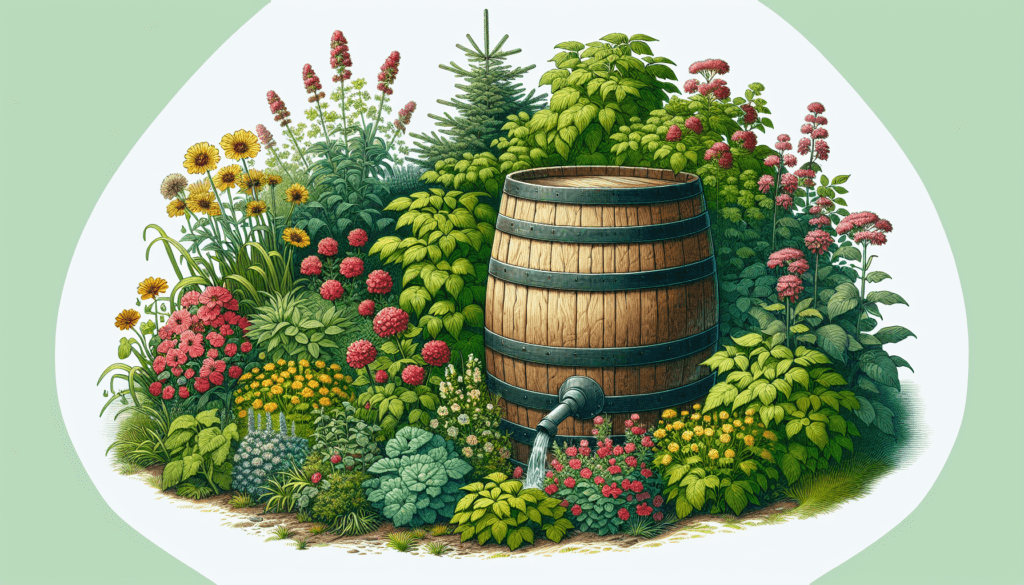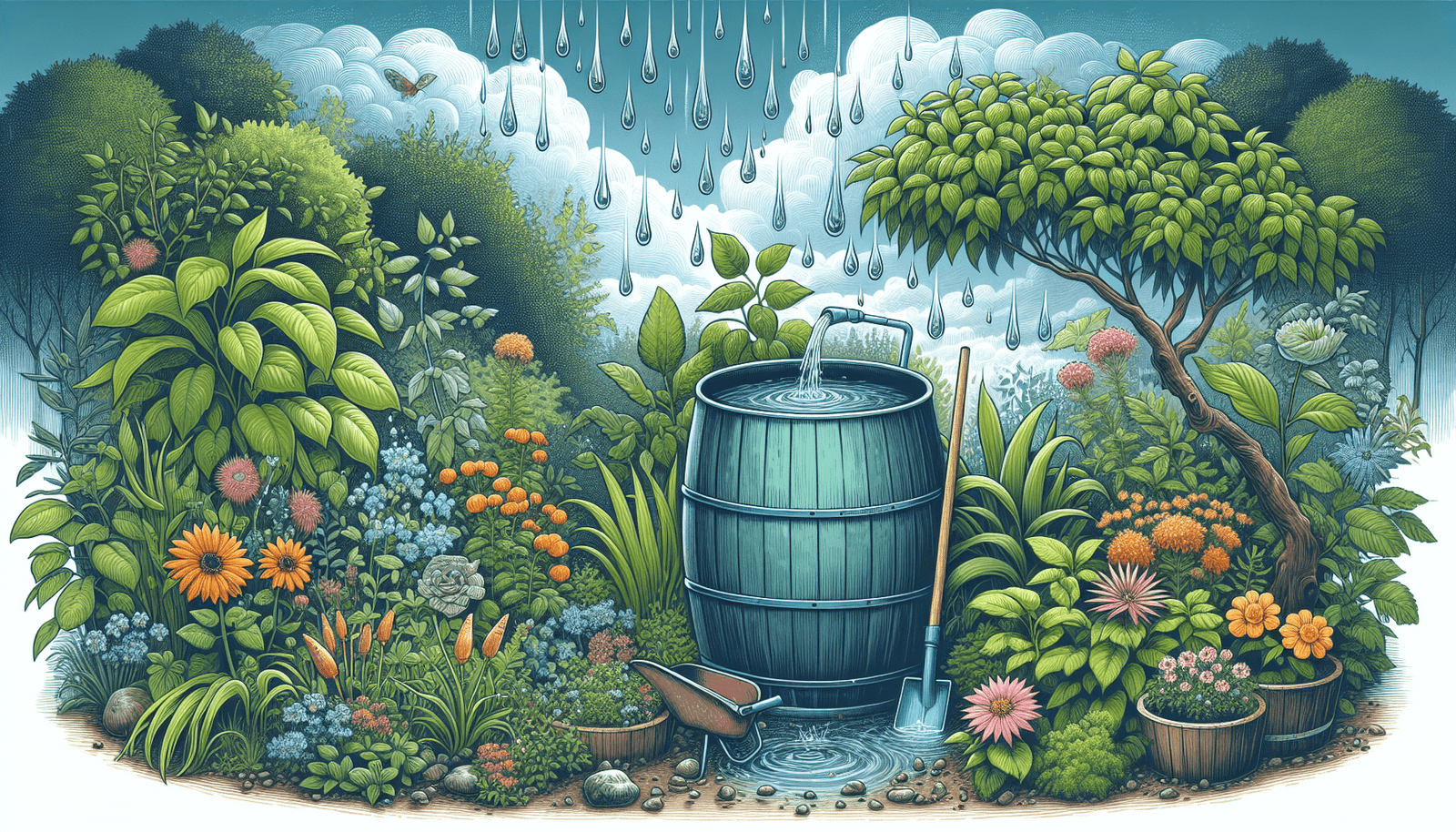Imagine having a lush, bountiful garden that thrives all year round, without putting a strain on your water bill or the environment. With the simple addition of rain barrels, you can achieve just that. In this article, we will explore the many benefits of using rain barrels in your garden and provide you with practical tips on how to make the most of this eco-friendly solution. Get ready to transform your garden into a water-saving haven that blooms with beauty and sustainability!
Benefits of using rain barrels in your garden
Conservation of water resources
Using rain barrels in your garden is a great way to conserve water resources. Instead of relying solely on water from the municipal supply or well, you can harness the power of rainfall to water your plants. By collecting rainwater, you are reducing the demand for potable water, which is especially important in areas with water scarcity or during droughts. This helps to protect our valuable water resources and ensure their availability for future generations.
Reduction in water bills
One of the most immediate benefits of using rain barrels in your garden is the reduction in your water bills. By using the rainwater collected in your barrels to water your plants and garden, you can cut down on the amount of water you need to draw from your municipal supply or well. This can lead to significant savings over time, especially during the dry summer months when water usage tends to be high. Just imagine the extra money you can save to spend on other garden improvements!
Promotion of plant growth
Rainwater is naturally free of chlorine and other chemicals that are often added to municipal water supplies. Consequently, it is an excellent source of water for plants. Rainwater contains essential nutrients that are beneficial for plant growth and development. By using rain barrels to water your plants, you are providing them with the purest form of water, allowing them to thrive and reach their full potential. Your garden will be lush and vibrant, thanks to the nourishing properties of rainwater.
Reduced stormwater runoff
Stormwater runoff can pose a significant challenge for the environment. When it rains, water runs off surfaces such as roofs, driveways, and streets, carrying pollutants and contaminants into our waterways. This can lead to water pollution and the degradation of ecosystems. By using rain barrels and capturing rainwater, you are reducing the amount of stormwater runoff that occurs on your property. This helps to protect and preserve the quality of our water bodies, ensuring a healthier environment for all.
Choosing the right rain barrel
Consider the size and capacity
When choosing a rain barrel for your garden, it is important to consider the size and capacity that will best suit your needs. Think about the amount of rainfall you receive in your area and the size of your garden. If you have a large garden or live in an area with heavy rainfall, you may want to opt for a larger capacity rain barrel. On the other hand, if you have a small garden or limited space, a smaller rain barrel may be more appropriate. Determine how much water you will need to collect and use to make an informed decision.
Select a material that suits your needs
Rain barrels come in different materials, each with their own advantages and disadvantages. Common materials include plastic, wood, and metal. Plastic barrels are lightweight, affordable, and easy to maintain. Wood barrels are aesthetically pleasing but require more maintenance to prevent rotting. Metal barrels are durable but may be heavier and more expensive. Consider your preferences, budget, and the climate in your area when choosing the material for your rain barrel.
Look for additional features
Some rain barrels come with additional features that can enhance their functionality and convenience. Look for barrels with built-in filters to prevent debris from entering the barrel. A spigot or hose attachment can make it easier to access the water and distribute it to your plants. Overflow valves are also useful to redirect excess water away from your foundation or into irrigation systems. Consider these additional features when selecting a rain barrel to make your gardening experience more enjoyable.
Ensure proper lid and screen
When choosing a rain barrel, it is essential to ensure that it has a proper lid and screen. The lid should be tight-fitting to keep out debris, insects, and animals. A screen on the top or intake area of the barrel will prevent leaves, twigs, and other larger particles from entering the barrel, ensuring the collected water remains clean and free from contaminants. These features are crucial for maintaining the quality of the rainwater and preventing any issues or blockages within your rain barrel system.

Placement of rain barrels
Identify the ideal location
Choosing the right location for your rain barrel is key to maximizing its effectiveness. Look for an area in your garden that receives the most rainfall and is easily accessible. This could be near a downspout, beneath a gutter system, or adjacent to a sloping surface. Pay attention to potential obstacles, such as overhanging branches or structures, that could interfere with the placement of your rain barrel. The aim is to position it strategically to capture the most rainwater possible.
Consider accessibility and convenience
When placing your rain barrel, it is important to consider accessibility and convenience. You will want it to be easily accessible so that you can conveniently access the water when needed. Consider the distance from your garden and the height of the barrel, ensuring it is within reach of a watering can or hose. If possible, try to position the barrel on a raised platform or sturdy base to elevate it off the ground for easier access and to provide gravity-fed water pressure.
Ensure stability and support
A stable and well-supported rain barrel is essential to prevent accidents and ensure its longevity. Ensure that the surface on which the barrel is placed is level and can support the weight of a full barrel. If necessary, use a sturdy stand or platform to provide additional stability. If you live in an area prone to strong winds, it may be necessary to secure the barrel further using straps or stakes. By taking these precautions, you can rest assured that your rain barrel will remain secure and functioning optimally.
Preparing your rain barrel
Clean and maintain the barrel
Before installing your rain barrel, it is important to clean and maintain it properly. Start by thoroughly rinsing out the barrel with clean water to remove any residue or contaminants. Avoid using harsh chemicals or detergents, as these can be harmful to plants and the environment. Periodically clean the barrel to remove any sediment or buildup that may accumulate over time. Regular maintenance will ensure the longevity of your rain barrel and the quality of the collected rainwater.
Remove debris and insects
Inspect your rain barrel regularly for any debris, such as leaves, twigs, or insects, that may have entered the barrel. Use a fine mesh screen or filter to prevent these from entering the barrel in the first place. Remove any debris or insects that you come across to maintain the cleanliness of the water and prevent clogs or blockages in your rain barrel system. This simple step will go a long way in preserving the quality of the rainwater and ensuring its usability for your garden.
Inspect for leaks or damage
As part of your regular maintenance routine, inspect your rain barrel for any leaks or damage. Look for cracks, holes, or deteriorating seals that may compromise the integrity of the barrel. Address any issues promptly by repairing or replacing the affected parts. Regular inspections and repairs will help to maintain the functionality of your rain barrel and prevent any water wastage or potential damage to your garden or property.
Install a diverter system
To maximize the functionality of your rain barrel, consider installing a diverter system. A diverter system allows you to automatically redirect excess water away from the barrel when it is full, preventing overflow and potential water damage. It also ensures a continuous flow of rainwater to your gardens and plants. Diverter systems come in various designs, so choose one that best suits your needs and the capacity of your rain barrel. Installing a diverter system is a simple but effective way to optimize your rainwater collection system.
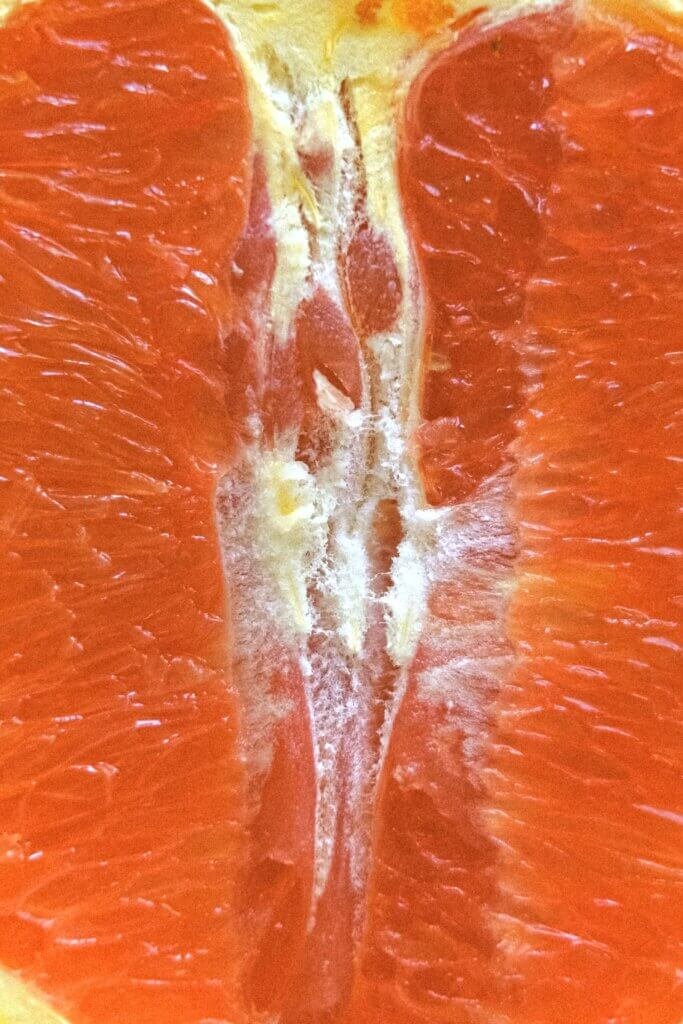
Connecting a rain barrel to your downspout
Choose the right downspout diverter
When connecting your rain barrel to a downspout, it is important to choose the right downspout diverter. A diverter is a device that allows you to direct the flow of rainwater into your rain barrel while still providing an outlet for excess water to flow away when the barrel is full. Look for a diverter that is compatible with your downspout size and material. Consider whether you want a manual or automatic diverter, as well as any additional features that may enhance its functionality.
Install the diverter correctly
Proper installation of the downspout diverter is crucial to the effective operation of your rain barrel system. Follow the manufacturer’s instructions carefully and ensure that the diverter is securely attached to your downspout. Pay attention to the positioning and angle of the diverter to ensure that the rainwater flows smoothly into the barrel without any leaks or blockages. Double-check all connections and seals to minimize any potential issues that may arise down the line.
Attach the diverter to the barrel
Once the downspout diverter is installed, it is time to attach it to your rain barrel. This is usually done using a hose or connector that allows water to flow from the diverter outlet into the barrel. Ensure a secure and watertight connection between the diverter and the barrel to prevent any leaks or water wastage. Test the connection by running water through the system and check for any signs of leakage. Adjust or tighten the connection as needed to ensure a proper fit.
Using rainwater from your barrel
Watering plants and gardens
One of the primary uses of rainwater collected in your barrel is for watering plants and gardens. Fill up your watering can or connect a hose to the spigot of your rain barrel and distribute the water directly to your plants. This provides them with the natural and nutrient-rich water they need to thrive. Watering plants with rainwater can also help to prevent fertilizer burn, as rainwater naturally has a balanced pH level and does not contain harsh chemicals or additives often found in tap water.
Washing outdoor tools and equipment
Rainwater can also be used for washing outdoor tools and equipment. Whether you need to clean your gardening tools, children’s toys, or outdoor furniture, rainwater is a great option. Fill up a bucket or use a hose connected to your rain barrel and enjoy the convenience of free water for your outdoor cleaning needs. Using rainwater for these purposes not only saves you money on your water bill but also reduces the demand for treated water, benefiting both your wallet and the environment.
Cleaning patio furniture or vehicles
Rainwater is ideal for cleaning patio furniture or vehicles. The natural purity of rainwater makes it a gentle and effective cleaning agent. Simply fill a bucket or attach a hose to your rain barrel, and you’ll have a ready supply of water for all your cleaning tasks. The absence of chemicals in rainwater ensures that your furniture or vehicle won’t be exposed to potentially harmful substances. Plus, using rainwater for these tasks reduces the need for expensive and environmentally unfriendly cleaning products.
Pets and wildlife watering
Rainwater from your barrel can also be utilized for watering pets and providing a source of water for wildlife. Fill up a pet water dish or a birdbath with the rainwater, ensuring that these animals have access to clean and fresh water. This is especially important during dry periods when natural water sources may be scarce. By using rainwater for these purposes, you promote the well-being of animals and reduce reliance on treated water, benefiting both the environment and your furry friends.
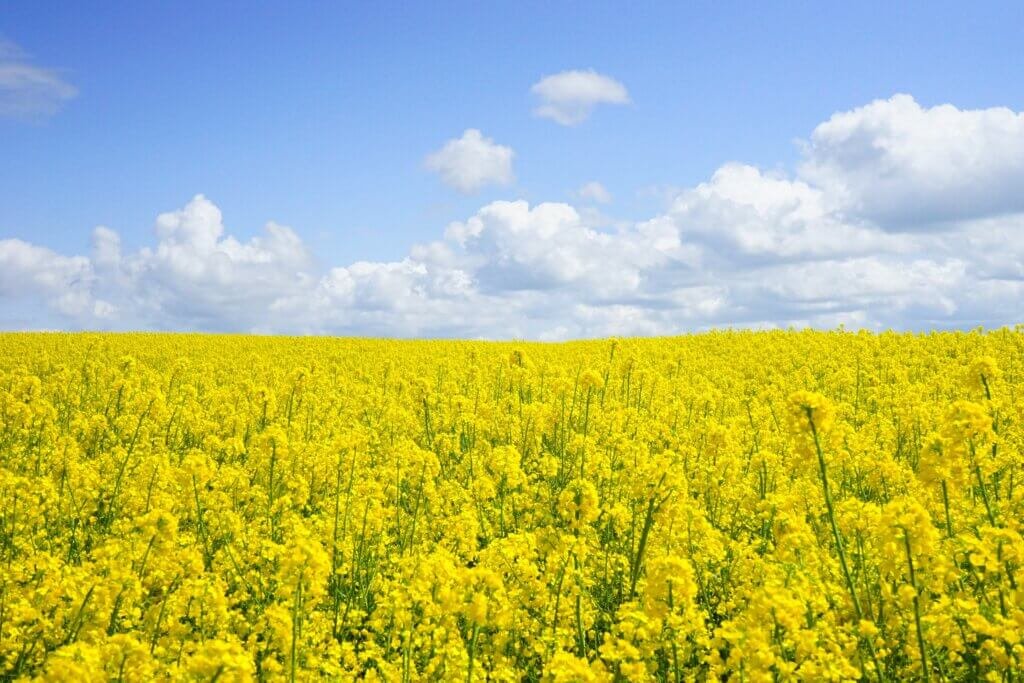
Tips for maximizing rainwater usage
Place barrels strategically
To maximize the amount of rainwater you can collect, place your rain barrels strategically. Position them in areas of your property that receive the most rainfall, such as beneath downspouts or in natural basins. Consider the slope of your property and the flow of water to ensure optimal water capture. If you have multiple rain barrels, connect them in a series to increase your water storage capacity. By strategically placing your rain barrels, you can capture the most rainwater possible and make the most of this valuable resource.
Use a soaker hose or drip irrigation system
When using rainwater collected in your barrel to water your plants, consider using a soaker hose or drip irrigation system. These methods deliver water directly to the roots of your plants, minimizing evaporation and ensuring efficient water usage. Soaker hoses release water slowly and evenly along their entire length, while drip irrigation systems use individual emitters to deliver water directly to each plant. By using these methods, you can save even more water and provide targeted hydration to your plants.
Apply mulch to retain moisture
To further conserve water and maximize the benefits of rainwater, apply mulch to the soil around your plants. Mulch acts as a protective layer, reducing evaporation and helping the soil retain moisture. By retaining more moisture in the soil, you reduce the frequency of watering needed, saving both water and time. Organic mulches, such as wood chips or straw, also provide additional nutrients as they break down, further promoting healthy plant growth. Mulching is a simple and effective way to conserve water and optimize the use of rainwater in your garden.
Use rainwater within a week for best results
Rainwater, while naturally pure, can become stagnant if left unused for a long period. It is recommended to use the rainwater collected in your barrel within a week for optimal results. This ensures that the water remains fresh and free from potential contamination. Regularly empty and refill your rain barrel as needed to prevent the buildup of stagnant water and maintain the quality of the collected rainwater. By using the water promptly, you can make the most of its benefits and ensure a healthy and productive garden.
Maintaining and winterizing your rain barrel
Regularly check for debris and clogs
Regular maintenance of your rain barrel is essential to keep it functioning properly. Periodically check the barrel and screen for any debris, such as leaves or twigs, that may have accumulated. Remove any debris to prevent clogs or blockages in the system. If you notice any signs of sediment or algae growth, clean the barrel accordingly. By regularly checking for debris and clogs, you can ensure that the rainwater collected remains clean and the system operates at its best.
Clean the barrel periodically
As part of your maintenance routine, it is important to clean the barrel periodically to maintain its functionality. Empty the barrel and rinse it thoroughly with clean water. Avoid using any harsh chemicals or detergents, as these can be harmful to plants and the environment. Use a soft-bristle brush or sponge to scrub the interior of the barrel, paying attention to any areas with buildup or residue. Rinse the barrel again to remove any residual cleaning agents. Regular cleaning will help to prevent contamination and ensure the quality of the rainwater.
Prepare for winter freezes
If you live in an area that experiences freezing temperatures during the winter, it is important to take steps to protect your rain barrel. Freezing water can expand, potentially damaging the barrel. Before the onset of winter, empty the rain barrel and disconnect it from the downspout. Store the barrel in a protected area, such as a garage or shed, to prevent it from freezing. If storing the barrel is not an option, consider insulating it with a cover or wrapping it with insulating material. By taking these precautions, you can avoid costly damage to your rain barrel.
Protect against algae growth
Algae growth can be a common issue in rain barrels, especially if they are exposed to sunlight. While algae itself is not harmful, it can cause unpleasant odors and affect water quality. To prevent algae growth, consider storing your rain barrel in a shaded area or using a barrel with a dark-colored exterior that minimizes sunlight penetration. It is also helpful to keep the barrel clean and clear of debris, which can provide nutrients for algae growth. Regularly monitoring and addressing any signs of algae growth will help to maintain the quality of the collected rainwater.
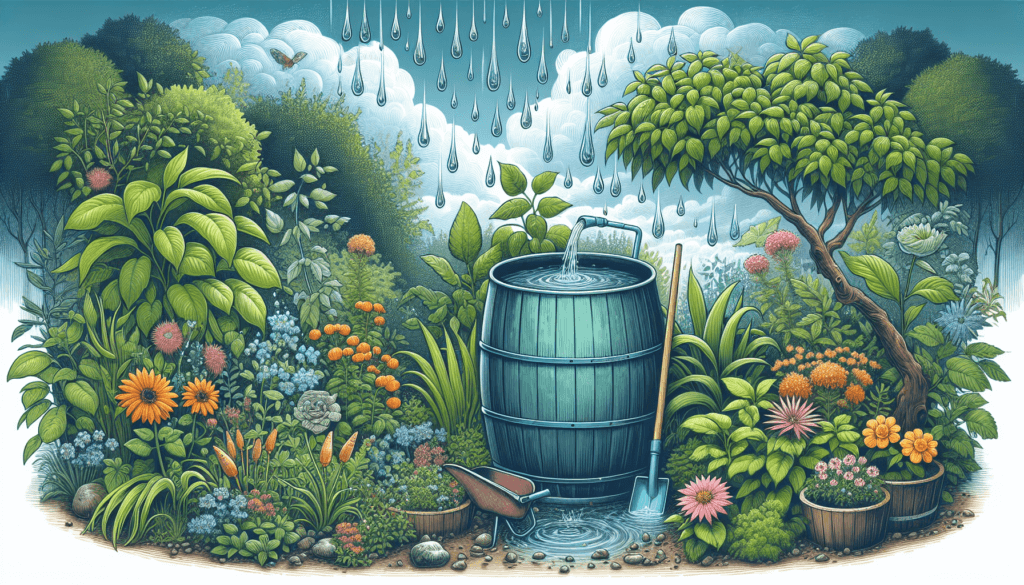
Troubleshooting common issues
Overflowing barrel
An overflowing barrel can be a common issue, especially during heavy rainfall or when the barrel is full. To prevent overflowing, consider installing an overflow valve or diverter system. These devices redirect excess water away from the barrel and ensure that it does not overflow. Alternatively, you can connect multiple rain barrels in a series to increase your storage capacity. Regularly check for and address any issues with the overflow mechanism to prevent water wastage and potential damage to your property.
Mosquito breeding
Mosquitoes can be a concern when using rain barrels, as stagnant water can provide an ideal breeding ground for them. To prevent mosquito breeding, ensure that your rain barrel has a proper lid and screen that prevent mosquitoes from accessing the water. Install mosquito dunks or tablets, which contain a mosquito larvicide, to kill any mosquito larvae that may be present in the water. It is also important to empty and refill your rain barrel regularly to prevent the buildup of stagnant water. By taking these precautions, you can enjoy the benefits of your rain barrel without worrying about mosquitoes.
Leaks or cracks
Leaks or cracks in your rain barrel can compromise its functionality and lead to water wastage. Regularly inspect your barrel for any signs of leaks or cracks and address them promptly. Replace any damaged or deteriorating seals, connectors, or fittings. If the barrel itself has a crack, it may need to be repaired or replaced. Regular maintenance and inspections will help to identify any issues early on and ensure the integrity of your rain barrel system.
Clogged or slow drainage
Clogged or slow drainage can occur if debris, such as leaves or twigs, accumulates in your rain barrel or downspout diverter. Regularly check for any blockages and remove debris as needed. Clean the screen or filter on your barrel to prevent clogs. If you notice slow drainage, there may be a partial blockage or sediment buildup in the system. Disassemble the affected components and clean them thoroughly before reassembling. By addressing clogged or slow drainage promptly, you can maintain the efficiency of your rainwater collection system.
Conclusion
Rain barrels are an eco-friendly addition to your garden that offers numerous benefits. By using rain barrels, you can conserve water resources, reduce water bills, promote plant growth, and minimize stormwater runoff. When choosing a rain barrel, consider the size, material, and additional features that suit your needs. Proper placement, maintenance, and preparation are essential to optimize the functionality of your rain barrel. Connecting a rain barrel to your downspout requires choosing the right diverter and ensuring proper installation. Utilize the collected rainwater for various purposes in your garden, such as watering plants, washing tools, cleaning outdoor furniture, and providing water for pets and wildlife. Maximize rainwater usage by placing barrels strategically, using efficient watering methods, applying mulch, and using rainwater promptly. Regular maintenance and winterization are crucial for maintaining your rain barrel. Troubleshoot common issues, such as overflowing barrels, mosquito breeding, leaks or cracks, and clogged drainage. Overall, rain barrels are an easy-to-use and cost-effective solution for saving money and conserving water resources while enjoying the numerous benefits they offer for your garden.
